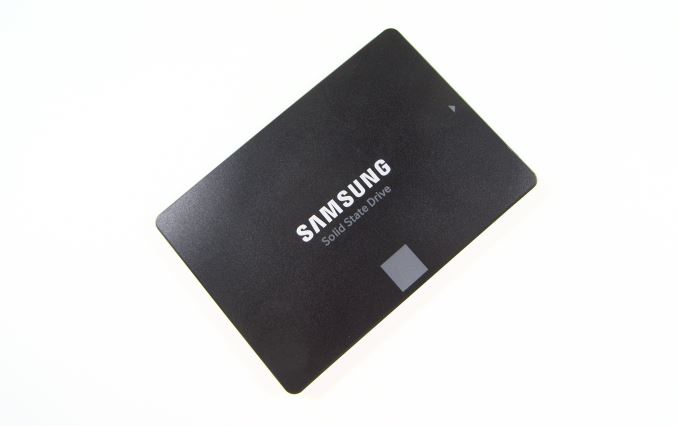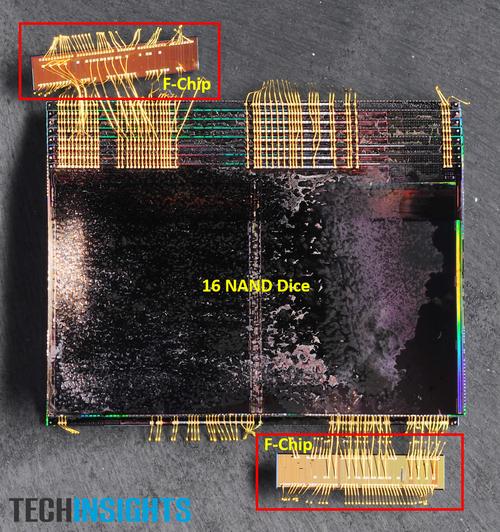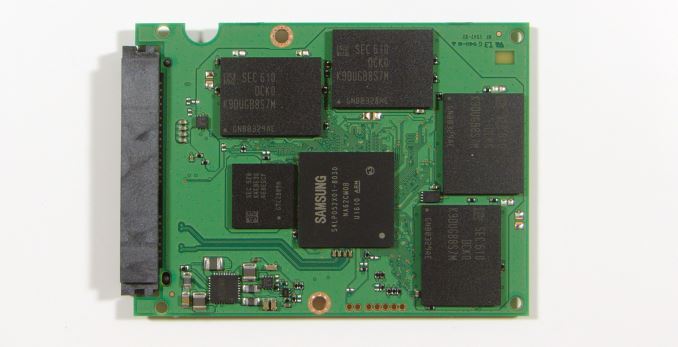The Samsung 850 EVO 4TB SSD Review
by Billy Tallis on July 11, 2016 10:00 AM EST
In 2014 Samsung brought 3D NAND (branded as V-NAND) to the consumer SSD market with the 850 Pro and 850 EVO SATA SSDs. Based on the MLC and TLC versions respectively of Samsung's 32-layer second-generation V-NAND process, both models raised the bar for SSD performance and remain essentially unchallenged except by PCIe SSDs. The 850 EVO in particular defies the usual image of TLC SSDs as being relatively slow, power-hungry, and susceptible to problems with long-term data retention or write endurance. Most TLC drives are low-end or at best mid-range in the SATA market, but the 850 EVO for the most part competes against MLC drives in the mid to high end of the market.
Last year, the 850 Pro and EVO lines were expanded with 2TB models based on an upgraded controller with support for the larger quantities of DRAM required to keep track of so much NAND flash memory. The 2TB 850 Pro introduced a 128Gb die version of Samsung's 32-layer MLC V-NAND to replace the 86Gb die used by the smaller 850 Pros. However the 2TB 850 EVO continued to use the same 128Gb TLC V-NAND as in the smaller capacities.
Later in 2015, Samsung announced their third-generation 48-layer V-NAND process to provide 256Gb MLC and TLC parts. The plan was to switch existing products like the 850 and 950 series SSDs over to the new V-NAND beginning in early 2016 and to introduce the higher capacities it enables. The transition to the newer V-NAND has not been as quick as originally planned, but we have seen it show up in the Portable SSD T3 and the 1TB 850 EVO M.2 that has recently become available.
The 48-layer V-NAND is now coming to the 2.5" 850 EVO line in the form of a new 4TB model. It turns out that the MHX controller introduced for the 2TB models supports 4GB of DRAM, so the new 4TB 850 EVO only required changing the NAND, bumping up to a higher-capacity DRAM chip, and a firmware revision. The rest of the drive—controller, PCB, and case—are identical to the 2TB model. It is a general rule that larger SSDs tend to be faster, but as we saw when the 2TB 850s showed up, the SATA interface doesn't leave much room for improvement and the overhead of managing more flash can sometimes slightly hurt performance. It's no surprise then that the performance specifications of the 4TB model are identical to that of the 500GB, 1TB and 2TB models. The idle power consumption rating of the 4TB 850 EVO is slightly higher than the 2TB model (likely due to the increased DRAM), but the new V-NAND gives the 4TB 850 EVO substantially lower active power consumption ratings than any previous capacity.
| Samsung SSD 850 EVO Specifications | |||||||
| Capacity | 120GB | 250GB | 500GB | 1TB (1000GB) | 2TB (2000GB) | 4TB (4000GB) | |
| Controller | MGX | MHX | |||||
| NAND | Samsung 32-layer 128Gbit TLC V-NAND | Samsung 48-layer 256Gbit TLC V-NAND | |||||
| DRAM (LPDDR3) | 256MB | 512MB | 1GB | 2GB | 4GB | ||
| Sequential Read | 540MB/s | ||||||
| Sequential Write (max) | 520MB/s | ||||||
| Sequential Write (non-TurboWrite) | 150MB/s | 300MB/s | 500MB/s | ||||
| 4KB Random Read (QD32) | 94K IOPS | 97K IOPS | 98K IOPS | ||||
| 4KB Random Write (QD32) | 88K IOPS | 90K IOPS | |||||
| 4KB Random Read (QD1) | 10K IOPS | ||||||
| 4KB Random Write (QD1) | 38K IOPS | 40K IOPS | |||||
| DevSleep Power | 2mW | 2mW | 2mW | 4mW | 5mW | 10mW | |
| Slumber Power | 50mW | 60mW | 70mW | ||||
| Active Power (Read/Write) | 3.7W / 4.4W | 3.7W / 4.7W | 3.1W / 3.6W | ||||
| Encryption | AES-256, TCG Opal 2.0, IEEE-1667 (eDrive) | ||||||
| Endurance | 75TB | 150TB | 300TB | ||||
| Warranty | Five years | ||||||
The one disappointment in the specifications for the 4TB 850 EVO is the write endurance rating, still the same 300TB total as the 2TB model. A warranty that expires after only 75 drive writes is concerning even if the total bytes written quantity has been reasonable in the past. It can come across as an indication that Samsung lacks confidence in their new V-NAND, which is at odds with the 5-year warranty the drive carries. For comparison, Samsung's enterprise PM863 based on the older 32-layer TLC V-NAND has a three year warranty but a 5600TB endurance rating for its 3.84TB model. Fortunately, it appears that the write endurance rating of the 4TB 850 EVO is very conservative: the testing subjected it to a total of around 7 drive writes but the SMART lifetime indicator is down to only 99% rather than the 90 or 91% implied by the 300TBW rating.
Meanwhile thanks to TechInsights, we know a bit about what makes it possible for Samsung's third generation V-NAND to offer higher capacities that are both more power efficient and more cost-effective. In addition to raising the layer count from 32 to 48, Samsung has tweaked several aspects of the design. The NAND cells still use a charge-trap design (in contrast to the floating gate used by planar NAND flash), but with some dimensions reduced, an extra metal interconnect layer, and more compact logic and I/O regions on the die. The net effect is that density has increased from about 1.86 Gb/mm^2 for the 32-layer TLC to about 2.6 Gb/mm^2 for the 48-layer TLC in this 4TB 850 EVO.
Another trick up Samsung's sleeve is the use of F-Chips, an idea they presented at ISSCC 2015. The F-Chips serve a similar purpose to the buffers on FB-DIMMs for DRAM: rather than directly connect the SSD controller to a stack of NAND dies using a multidrop bus, the F-Chip is an interface chip that is connected to the SSD controller, and it in turn connects to two groups of four NAND dies. Because the tiny F-Chip inhabits the same BGA package as the stack of NAND and because its connections to the NAND are shared across only four chips instead of 8 or 16, maintaining signal integrity is much less of a problem. Likewise, the sharing of the bus between the NAND package and the SSD controller is reduced or eliminated.

(Source: TechInsights via EETimes)
The original intent of this development was to allow for much higher throughput between the SSD controller and the NAND so that PCIe SSDs wouldn't need an extreme number of channels, but the reduced signal integrity concerns may have also allowed for some simplification of the I/O circuitry on the NAND chips. The F-Chip still presents a toggle-mode DDR interface to the SSD controller, so it is essentially transparent and doesn't require any controller modifications.
Given how SSD capacity is related to both performance and power consumption, we generally prefer to compare drives of similar capacities. The 4TB 850 EVO doesn't leave us any good options: most consumer SSD product lines still top out around 1TB, large enterprise SAS and PCIe SSDs wouldn't be a useful point of comparison and a RAID array of several smaller SATA SSDs wouldn't quite be fair either, and I don't even have a mechanical hard drive larger than 3TB handy. For now, the 4TB 850 EVO is in a class of its own. It should be joined soon by a 4TB 850 Pro, but other than that most of the competition will only be reaching 2TB capacities this year. For this review, the 4TB 850 EVO will be compared against the other capacities of Samsung 850 EVO and 850 Pro as well as the largest of several other SSD product lines that compete more directly against the smaller capacity 850 EVOs.
With a MSRP of $1499 (37.4¢/GB) the 4TB 850 EVO should not be significantly more expensive per-GB than the 2TB model, which carries only a modest premium over the most cost-effective 500GB and 1TB capacities. The total price may be shockingly high, but per gigabyte it is not unreasonable.
| AnandTech 2015 SSD Test System | |
| CPU | Intel Core i7-4770K running at 3.5GHz (Turbo & EIST enabled, C-states disabled) |
| Motherboard | ASUS Z97 Pro (BIOS 2701) |
| Chipset | Intel Z97 |
| Memory | Corsair Vengeance DDR3-1866 2x8GB (9-10-9-27 2T) |
| Graphics | Intel HD Graphics 4600 |
| Desktop Resolution | 1920 x 1200 |
| OS | Windows 8.1 x64 |
- Thanks to Intel for the Core i7-4770K CPU
- Thanks to ASUS for the Z97 Deluxe motherboard
- Thanks to Corsair for the Vengeance 16GB DDR3-1866 DRAM kit, RM750 power supply, Carbide 200R case, and Hydro H60 CPU cooler











145 Comments
View All Comments
Impulses - Monday, July 11, 2016 - link
I think it might take longer than that, the 1TB model hasn't budged much in the year since I bought 2, and neither has the 2TB after it's release... A 4TB faces even less direct competition than those do. I guess 3D NAND from others will eventually start to challenge Samsung tho, but it sure has taken them a while.mapesdhs - Wednesday, July 13, 2016 - link
I remember SanDisk saying not all that long ago that they wanted to release an 8TB model, but everything seems to have slowed down since then.I wonder sometimes if all of these companies are not really pushing the tech as fast as it could go because all of them in the meantime can make some decent money selling the various inbetween capacities.
Really it's kinda ridiculous that it's still possible to buy 128GB and lesser models, they're such price ripoffs. I remember that the 850 EVO 250GB went as low as 53 UKP over the xmas break, but now most places have it up past 75, while plenty of 120GB models are more than 50.
Just wish the public would stop buying the overpriced lower grade stuff.
Magichands8 - Monday, July 11, 2016 - link
And the reason this isn't being released with U.2 would be.....? Oh that's right! There isn't a reason. It was intentionally gimped with SATA performance. Great job Samsung! And it's only 4 times more expensive than it should be! Yep, I'm very glad that Optane is getting closer. I realize it isn't going to be super cheap at the start but it will be very interesting to see how it changes the landscape and what affect it has on the SSD market.Impulses - Tuesday, July 12, 2016 - link
More than likely they'll be faster, more expensive per GB, and smaller... :p AFAIK it'll compete with PCI-E & M.2 drives so it'll be priced accordingly, and that's ignoring that it'll likely require a whole new platform etc.Looking at a large capacity EVO as a purposeful gimping is very odd, the controller was originally designed and has always been used as a SATA controller.
You could maybe make that claim of a 2TB 950 Pro or something (if and when it happens)... But it's all but impossible to know how this series' controller would do on a different interface, or if that's even possibly.
Magichands8 - Tuesday, July 12, 2016 - link
It's laziness is what it is. And an attempt to milk more out of their SATA controller design. It's time though for the older technology to go the way of the Dodo. For years we've been hobbled by SATA and it doesn't make sense to me to have huge capacities and slow performance anymore. I'm glad to see Samsung releasing such a high capacity SSD but I'm almost insulted by the fact that so many "new" SSDs are being released based upon older technology and crippled by all of its limitations.Impulses - Wednesday, July 13, 2016 - link
A vast majority of people don't need anything better than SATA, so the R&D to go forth is balanced against that I'm sure... Like it or not, anything PCI-E/M.2/U.2 is still a niche right now... And it'd be a tiny niche if M.2 didn't also happen to be a decent form factor for laptops.Enthusiasts and power users are basically lucky that the mobile sector kinda spurred some performance innovation for once even if it's also kinda casting a shadow on U.2. Samsung's in it to maximize profits like anyone else...
mapesdhs - Wednesday, July 13, 2016 - link
Unfortunately the manufacturers know that at least for a while the niche status of tech like M.2 will allow them to charge much more for such products, pulling in people who can afford it and are willing to pay the premium. In theory competition should solve this, but sometimes I do wonder about possible pricing collusion when certain products seem to go through a particularly fishy looking price fluctuation.AnnonymousCoward - Tuesday, July 12, 2016 - link
Gimped with SATA? You do realize everything is CPU-bound unless you're copying to a RAM drive or running a benchmark, right? If you want to speed things up, buy a 6700K and OC it.KoolAidMan1 - Monday, July 11, 2016 - link
I can't wait until price per GB drops some more. Its actually very affordable by that metric but I'd still want to wait for it to drop to around $800 before buying one myself.Impulses - Tuesday, July 12, 2016 - link
It'll be a while, the 2TB is like $600 and has barely dropped by $100 since launching last year... Once those hit $500 or less I could be in for one, unless the 4TB's price has also budged a ton by then. I think the largest capacity always sees the smallest dips tho, specially in this case where competition is non existent.